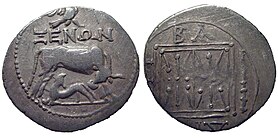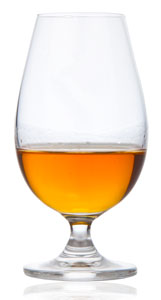Dram (unit)

The dram (alternative British spelling drachm; apothecary symbol ʒ or ℨ;[a] abbreviated dr)[4][5]: C-6–C-7 [6] is a unit of mass in the avoirdupois system, and both a unit of mass and a unit of volume in the apothecaries' system.[5] It was originally both a coin and a weight in ancient Greece.[7] The unit of volume is more correctly called a fluid dram, fluid drachm, fluidram or fluidrachm (abbreviated fl dr, ƒ 3, or fʒ).[4][5]: C-17 [6][8][9][10]
Ancient unit of mass
[edit]
- The Attic Greek drachma (δραχμή) was a weight of 6 obols, 1⁄100 Greek mina, or about 4.37 grams.[11]
- The Roman drachma was a weight of 1⁄96 Roman pounds, or about 3.41 grams.[12][13]
A coin weighing one drachma is known as a stater, drachm, or drachma. The Ottoman dirhem (Ottoman Turkish: درهم) was based on the Sassanian drachm, which was itself based on the Roman dram/drachm.
British unit of mass
[edit]The British Weights and Measures Act 1878 introduced verification and consequent stamping of apothecary weights, making them officially recognized units of measurement. By 1900, Britain had enforced the distinction between the avoirdupois and apothecaries' versions by making the spelling different:[14]
- dram now meant only avoirdupois drams, which were 1⁄16 of an avoirdupois ounce. An ounce consisted of 437.5 grains, thus making the dram approximately 27.34 grains.
- drachm now meant only apothecaries' drachms, which were 1⁄8 of an apothecaries' ounce of 480 grains, thus equal to 60 grains.
Modern unit of mass
[edit]In the avoirdupois system, the dram is the mass of 1⁄256 pound or 1⁄16 ounce.[5]: C-6 The dram weighs 27+11⁄32 grains,[5]: C-6 or exactly 1.7718451953125 grams.[5]: C-14
In the apothecaries' system, which was widely used in the United States until the middle of the 20th century,[15] the dram is the mass of 1⁄96 pounds apothecaries (lb ap), or 1⁄8 ounces apothecaries (oz ap or ℥)[5]: C-7 (the pound apothecaries and ounce apothecaries are equal to the troy pound (lb t), and troy ounce (oz t), respectively).[5]: C-6–C-7 The dram apothecaries is equal to 3 scruples (s ap or ℈) or 60 grains (gr),[5]: C-7 or exactly 3.8879346 grams.[5]: C-14
"Dram" is also used as a measure of the powder charge in a shotgun shell, representing the equivalent of black powder in drams avoirdupois.[16]
Unit of volume
[edit]
The fluid dram (or fluid drachm in British spelling[17]) is defined as 1⁄8 of a fluid ounce,[5]: C-5, C-7 and is exactly equal to:
- 3.6966911953125 ml in the U.S. customary system[5]: C-5, C-12
- 3.5516328125 ml in the British Imperial system[5]: C-7 [18]
A teaspoonful has been considered equal to one fluid dram for medical prescriptions.[19] However, by 1876 the teaspoon had grown considerably larger than it was previously, measuring 80–85 minims.[20] As there are 60 minims in a fluid dram,[5]: C-5, C-7 using this equivalent for the dosage of medicine was no longer suitable.[20] Today's US teaspoon is equivalent to exactly 4.92892159375 ml, which is also 1⁄6 US fluid ounces, 1+1⁄3 US fluid drams,[5]: C-18 or 80 US minims.[5]: C-5
While pharmaceuticals are measured nowadays exclusively in metric units, fluid drams are still used to measure the capacity of pill containers.
Dram is used informally to mean a small amount of liquor, especially Scotch whisky.[21][7] The unit is referenced by the phrase dram shop, the U.S. legal term for an establishment that serves alcoholic beverages.[22]
In popular culture
[edit]The line "Where'd you get your whiskey, where'd you get your dram?" appears in some versions of the traditional pre–Civil War American song "Cindy".[23] In the Monty Python's song "The Bruces' Philosophers Song", there is the line "Hobbes was fond of his dram". In the old-time music tradition of the United States, there is a tune entitled "Gie the Fiddler a Dram",[24][25] "gie" being the Scots language word for "give", brought over by immigrants and commonly used by their descendants in Appalachia at the time of writing. "Little Maggie," a traditional song popular in bluegrass music, refers to the title character as having a "dram glass in her hand."[26]
In the episode "Double Indecency" of the TV series Archer, the character Cheryl/Carol was carrying around 10 drams of Vole's blood and even offered to pay for a taxi ride with it.
In Frank Herbert's Dune, the Fremen employ a sophisticated measurement system that involves the drachm (and fractions thereof) to accurately count and economize water, an ultra-precious resource on their home, the desert planet Arrakis.
Notes
[edit]- ^ In Unicode, a standard designed to allow symbols from all writing systems to be represented and manipulated by computers, the dram symbol has no dedicated symbol.[1] Typically, the lowercase ezh, or "tailed z", (ʒ) is used,[2] and the Unicode code table entry for ʒ reads "LATIN SMALL LETTER EZH = dram sign".[3] However, the upper-case letter z in Blackletter/Fraktur hand. i.e. ℨ is also seen. Found in Unicode Mathematical Alphanumeric Symbols block, ℨ is meant to be used in mathematics and phonetics, and is not recommended as an abbreviation for dram.
References
[edit]- ^ "Unicode: where is the Drachma sign?" typedrawers.com.
- ^ William R. Newman et al. "Toward a Proposal for an Alchemy Unicode Plane." 12 August 2008.
- ^ "IPA Extensions. Range: 0250–02AF" The Unicode Standard, Version 15.1. 2023.
- ^ a b Simpson, John A.; Weiner, Edmund S.C., eds. (1989). "drachm, n.". Oxford English Dictionary (2nd ed.). Oxford, England: Oxford University Press. ISBN 978-0-19-861186-8. OCLC 50959346. Retrieved 2 July 2012.
Spelt drachm or dram.
Earlier version first published in New English Dictionary, 1897. - ^ a b c d e f g h i j k l m n o p National Institute of Standards and Technology (October 2011). Butcher, Tina; Cook, Steve; Crown, Linda et al. eds. "Appendix C – General Tables of Units of Measurement" (PDF). Specifications, Tolerances, and Other Technical Requirements for Weighing and Measuring Devices. NIST Handbook. 44 (2012 ed.). Washington, D.C.: U.S. Department of Commerce, Technology Administration, National Institute of Standards and Technology. ISSN 0271-4027. OCLC OCLC 58927093. Retrieved 1 July 2012.
- ^ a b Boyer, Mary Jo (2009). "UNIT 2 Measurement Systems: The Apothecary System". Math for Nurses: A Pocket Guide to Dosage Calculation and Drug Preparation (7th ed.). Philadelphia, PA: Wolters Kluwer Health | Lippincott Williams & Wilkins. pp. 108–9. ISBN 978-0-7817-6335-6. OCLC 181600928. Retrieved 2 July 2012.
- ^ a b Simpson, John A.; Weiner, Edmund S.C., eds. (1989). "dram, n.". Oxford English Dictionary (2nd ed.). Oxford, England: Oxford University Press. ISBN 978-0-19-861186-8. OCLC 50959346. Retrieved 2 July 2012. Earlier version first published in New English Dictionary, 1897.
- ^ Royal College of Physicians of Dublin (1850). "Weights and Measures". The Pharmacopœia of the King and Queen's College of Physicians in Ireland. Dublin: Hodges and Smith. p. xlvi. hdl:2027/mdp.39015069402942. OCLC 599509441.
- ^ "fluidram". Merriam-Webster online. Springfield, MA: Merriam-Webster. OCLC 44475779. Retrieved 2 July 2012.
Definition of FLUIDRAM: variant of fluid dram
- ^ Powell, Richard; Royal College of Physicians of London (1809). "Weights, Measures, &c. [measures of liquids sect.]". The Pharmacopœia of the Royal College of Physicians of London, M. DCCC. IX. Pharmacopoeia Londinensis.English (corr. and enl. 2nd ed.). London: Longman, Hurst, Rees, and Orme. p. 3. hdl:2027/wu.89097444632. OCLC 622876101.
- ^ Donald J. Mastronarde (19 March 1993). Introduction to Attic Greek. University of California Press. p. 222. ISBN 978-0-520-07844-4. Retrieved 30 June 2012.
- ^ Smith, William (1886). Dictionary of Greek and Roman Antiquities (3rd American ed.). New York: Harper & Brothers. p. 1062. Retrieved 1 July 2012.
- ^ Ramsay, William Wardlaw (1883). An elementary manual of Roman antiquities (7th ed.). London: Charles Griffin and Company. p. 206. Retrieved 1 July 2012.
- ^ "Apothecaries Weights". Retrieved 2016-09-21.
- ^ Judson, Lewis V. (March 1976) [October 1963]. "Appendix 8". Weights and Measures Standards of the United States: A brief history (PDF). NBS Special Publication. Vol. 447. Washington, D.C.: U.S. Department of Commerce, National Bureau of Standards. p. 35. OCLC 610190761. Archived from the original (PDF) on 3 June 2011. Retrieved 1 July 2012.
- ^ Buzzacott, Francis H.; Boyles, Denis (3 August 2008). The Complete Sportsman's Encyclopedia. Globe Pequot. p. 271. ISBN 978-1-59921-330-9. Retrieved 1 July 2012.[permanent dead link]
- ^ "The Weights and Measures Act 1985 (Metrication) (Amendment) Order 1994". www.legislation.gov.uk.
- ^ United Kingdom; Department of Trade and Industry (1995). The Units of Measurement Regulations 1995. London: HMSO. Schedule: Relevant Imperial Units, Corresponding Metric Units and Metric Equivalents. ISBN 978-0-11-053334-6. OCLC 33237616. Retrieved 1 July 2012.
- ^ Simpson, John A.; Weiner, Edmund S.C., eds. (1989). "tea-spoon, n.". Oxford English Dictionary (2nd ed.). Oxford, England: Oxford University Press. ISBN 978-0-19-861186-8. OCLC 50959346. Retrieved 2 July 2012.
teaspoonful n. as much as a tea-spoon will hold; in medical prescriptions taken as equal to 1 fluid-drachm.
Earlier version first published in New English Dictionary, 1911. - ^ a b Bidwell, W. H., ed. (July–December 1876). "Domestic Measurement of Medicine". The Eclectic Magazine of Foreign Literature, Science, and Art. 87. New York: Leavitt, Trow, & Co.: 766–7. hdl:2027/uc1.b2870858. OCLC 700637572.
- ^ "Why is a measure of whisky called a dram?". TopWhiskies. Retrieved 2022-04-10.
- ^ Ritter, Francis D. (2000). Successful Personal Injury Investigation: Master the Techniques of Finding the Facts that Win Cases for Plaintiff Attorneys (First ed.). Oceanside, California: Diverse Publications. p. 804.
- ^ Erbsen, Wayne (1993). Front Porch Songs, Jokes & Stories. Native Ground. p. 12.
- ^ "The Milliner - Koken Collection of American Fiddle Tunes". slippery-hill.com. Archived from the original on 8 October 2015. Retrieved 15 September 2015.
- ^ Brown, John. Gie the fiddler a dram. Rec. May 1939 by Herbert Halpert. Lib. of Cong. Web. 15 September 2015. <http://www.loc.gov/item/afc9999005.7452>.
- ^ "Little Maggie – Bluegrass Lyrics".
External links
[edit]- Appendix C – General Tables of Units of Measurement in Specifications, Tolerances, and Other Technical Requirements for Weighing and Measuring Devices. NIST Handbook 44 (2012 ed.).
- Image Archived 2014-12-02 at the Wayback Machine of Ancient Greek silver drachm with flying Pegasus, Acarnania, Leucas, c. 470–450 BCE